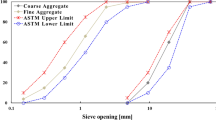Abstract
In recent years, high core temperatures of 77–93°C of mass concrete elements during curing have been recorded by the Florida Department of Transportation (FDOT). These curing temperatures have been recorded while still maintaining the maximum differential temperature of 20°C between the core and exterior of mass concrete elements as specified by the FDOT. This study was conducted to evaluate the strength and durability of concrete subjected to elevated curing temperatures. Using typical FDOT class IV mass concrete mixes; it is shown that elevated curing temperature resulted in lower later-age strengths. Blending the cement with fly ash and slag, resulted in increased strength and durability when compared to the plain cement mixes.
Résumé
Ces dernières années, le département des transports de la Floride—Florida Department of Transportation, FDOT—a enregistré des températures élevées de 77 à 93 degrés Celcius dans des blocs de béton massif en cours de séchage. Comme le précise le FDOT, ces températures de séchage ont été enregistrées alors qu’une température différentielle maximum de 20°C était maintenue entre l’intérieur et l’extérieur de ces blocs de béton massif. Cette étude fut conduite pour évaluer la solidité et la durabilité d’un béton exposé à des températures de séchage élevées. En utilisant du béton massif issue de mélanges typiques, classe IV, du FDOT, on démontre que la température de traitement élevée a eu comme conséquence des forces inférieures à un âge plus avancé. Les mélanges comportant une addition de scories et de cendres volantes se sont avérés plus solides et plus durables que ceux restés purs.
Similar content being viewed by others
References
Florida Department of Transportation, ‘Structures Design Guidelines (LRFD)’, 2002.
Mehta, P.K. and Monteiro, P.J.M., ‘Concrete: Microstructure, Properties, and Materials’, 2nd Edn. (United States, 1993).
Verbeck, G.J. and Helmuth, R.A., ‘Structures and physical properties of cement paste’, in ‘The Chemistry of Cement’, Proceedings of the 5th International Symposium, Tokyo, 1968 (3) 1–32.
Neville, A.M., ‘Properties of Concrete’, 4th Edn. (Harlow, England, 2004).
Goto, S. and Roy, D.M., ‘The effect of w/c ratio and curing temperature on the permeability of hardened cement paste’,Cement and Concrete Research 11 (7) (1981) 575–9.
Kjellsen, K.O., Detwiler, R.J. and Gjørv, O.E., ‘Pore Structure of Plain cement pastes hydrated at different Temperatures’,Cement and Concrete Research 20 (1990) 927–933.
American Society for Testing and Materials (ASTM), ‘ASTM C 39-96: Standard Test Method for Compressive Strength of Cylindrical Concrete Specimens’. Annual Book of ASTM Standards ASTM, Philadelphia.
American Society for Testing and Materials (ASTM), ‘ASTM C1202-97: Standard Test Method for Electrical Indication of Concrete’s Ability to Resist Chloride Penetration’ Annual Book of ASTM Standards, ASTM, Philadelphia.
Florida Department of Transportation (FDOT), FM 5-522: ‘An accelerated Laboratory Method for Corrosion of Reinforced Concrete Using Impressed Current’, Manual of Florida Sampling and Testing Method. FDOT, Tallahassee, Florida.
Author information
Authors and Affiliations
Rights and permissions
About this article
Cite this article
Chini, A.R., Acquaye, L. Effect of elevated curing temperatures on the strength and durability of concrete. Mat. Struct. 38, 673–679 (2005). https://doi.org/10.1007/BF02484312
Received:
Accepted:
Issue Date:
DOI: https://doi.org/10.1007/BF02484312




